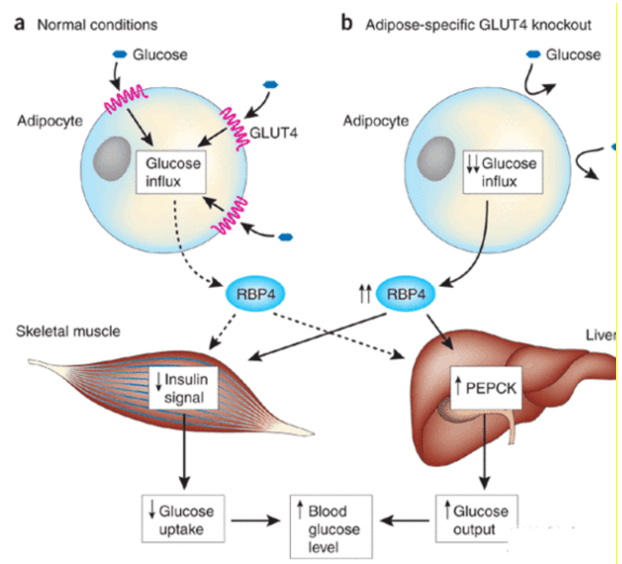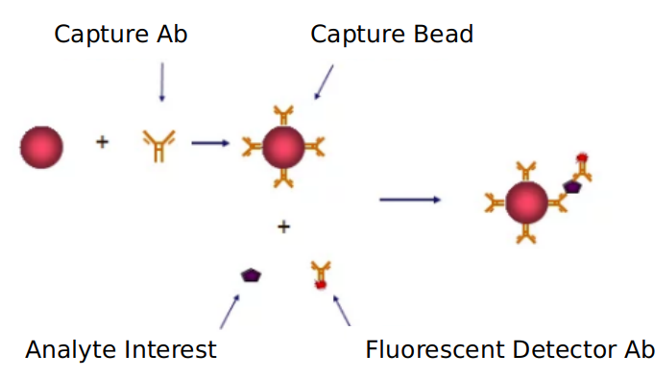RBP-4 signaling pathway
Based on Luminex technology platform, Creative Proteomics provides analysis services for key targets of RBP-4 signaling pathway.
 (Tabesh M, et al., 2017)Retinol binding protein4 (RBP4) is a newly discovered cytokine that belongs to the retinol binding protein (RBP) family and is mainly secreted by the liver and to a lesser extent by adipose tissue. In both animal and human studies, RBP4 has been found to play a key role in the development and progression of type 2 diabetes mellitus (T2DM), non-alcoholic fatty liver disease and atherosclerosis by participating in the regulation of glucose uptake and gluconeogenesis, and promoting insulin resistance.
(Tabesh M, et al., 2017)Retinol binding protein4 (RBP4) is a newly discovered cytokine that belongs to the retinol binding protein (RBP) family and is mainly secreted by the liver and to a lesser extent by adipose tissue. In both animal and human studies, RBP4 has been found to play a key role in the development and progression of type 2 diabetes mellitus (T2DM), non-alcoholic fatty liver disease and atherosclerosis by participating in the regulation of glucose uptake and gluconeogenesis, and promoting insulin resistance.
The serum RBP4 signaling pathway, through activation of ERK1 / 2 and JAK2 phosphorylation in the MAPK signaling pathway, increases water and sodium retention caused by hyperinsulinemia, overproliferation of vascular smooth muscle cells (VSMCs), and impairs the ability of vascular endothelial cells to synthesize nitric oxide, thus playing an important role in the development of hypertension. In addition, RBP4 is associated with MS, vascular smooth muscle cells (VSMCs) and vascular endothelial cells. The mechanism of interaction between RBP4 and MS, diabetic vascular complications and cancer is becoming clearer, it will provide better directions and ideas for the prevention and treatment of related diseases in the population.
The RBP4 gene variant was positively associated with hypertriglyceridemia and body mass index in the population. In addition, ectopic expression of RBP4 significantly reduced inguinal adipocyte diameter and fat deposition in mice, and mechanistic studies showed that RBP4 blocked the insulin signaling pathway by inhibiting the phosphorylation of serine/threonine kinase, thereby inhibiting the lipogenesis process in mice, suggesting an important association between RBP4 and the cause and effect of obesity.
Our detectable targets:
| RTK | TRIF | Fas | TLR4 | MEKK1 | RIP1 |
| TRAF3 | Tak1 | ISRE | Rac1 | IRF9 | icam1 |
| RIG-1 | TLR3 | NAP1 | MYD88 | GAS | Mda-5 |
| NFκB | MSK1 | PI3K | JNK | MSK2 | CREB |
| STAT3 | IRS2 | TBK1 | IRAK4 | ISGF3 | IRF3 |
| STAT2 | PSGL1 | Vav | STAT5 | TNFR | MAPK |
| STAT1 | SH2 | PKR | SLP76 | mTOR | TRAM |
| TYK2 | p38MAPK | TRAF5 | p50 | IRF5 | Rel |
| PI3K | MEK3 | IRS1 | MEK6 | CD3 | TLR9 |
Technology platform:
We provide Luminex technology for RBP-4 signaling pathway analysis.
Luminex technology is a multifunctional liquid phase analysis platform, which is developed on the basis of high-speed digital signal processing technology, colored microspheres, applied fluidics and laser technology. The core is the use of fluorescent dyes for encoding. By adjusting the different ratios of different fluorescent dyes, more than 100 microspheres with different fluorescence spectra were obtained. The reactions are carried out on microspheres with different fluorescent codes, such as nucleic acid hybridization, antigen-antibody, enzyme-substrate, ligand-receptor binding reactions. Using laser detection technology, qualitative and quantitative analysis of microsphere encoding and reporting fluorescence.
Advantages of RBP-4 signaling pathway detection:
- The operation is simple and quick: The liquid phase system is adopted, the reaction time is fast, and the detection of various cytokines can be completed within 2-3 hours.
- High throughput: It can analyze more than 100 target molecules in the same sample at the same time.
- Low sample consumption: Due to the small size of the microspheres, samples as low as 1 puL can be detected, and 100 different target molecules can be detected simultaneously in the same reaction well, which greatly saves the amount of sample.

Application of our service:
- Study the impact of each clinical virus on the RBP-4 signaling pathway
- Research on the regulatory mechanism of RBP-4 signaling pathway in medicine
Creative Proteomics has developed a signaling pathway target detection platform. We can provide detection services not only for RBP-4 signaling pathways, but also for other signaling pathways. If you want to detect other targets, please contact us in advance and we will customize the service for you according to your requirements. Looking forward to working with you.
References:
- Tabesh M, Noroozi A, et al. Association of retinol binding protein 4 with metabolic syndrome in first-degree relatives of type 2 diabetic patients. Res Med Sci, 2017, 22: 28-34.
- Codofer- Franch P, Carrasco-Luna J, et al. Association of RBP4 genetic variants with childhood obesity and cardiovascular risk factors. Pediatric Diabetes, 2016, 17: 76-583.



